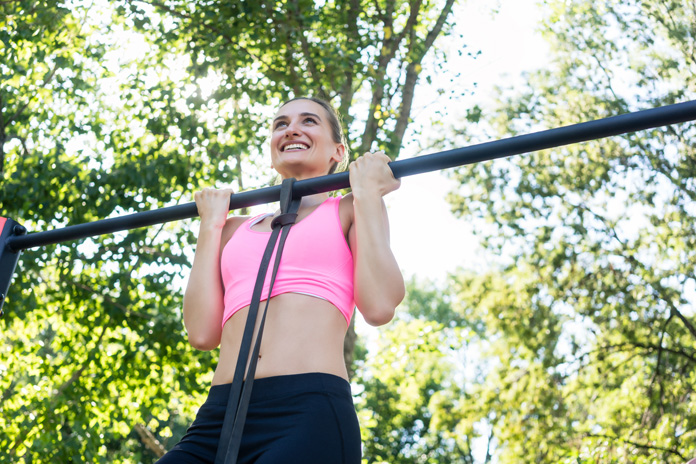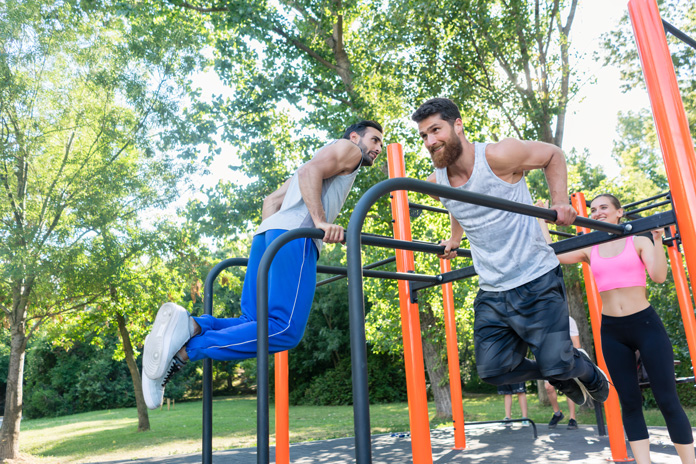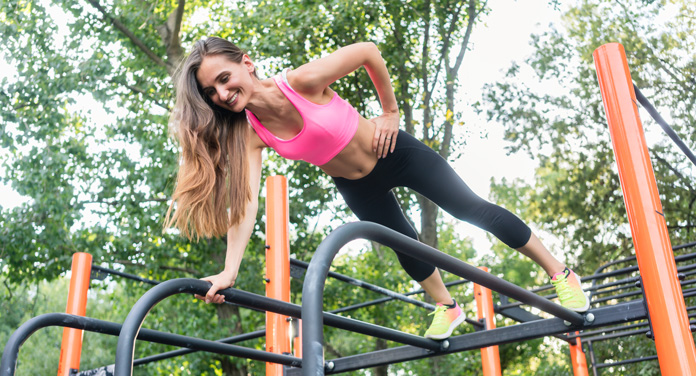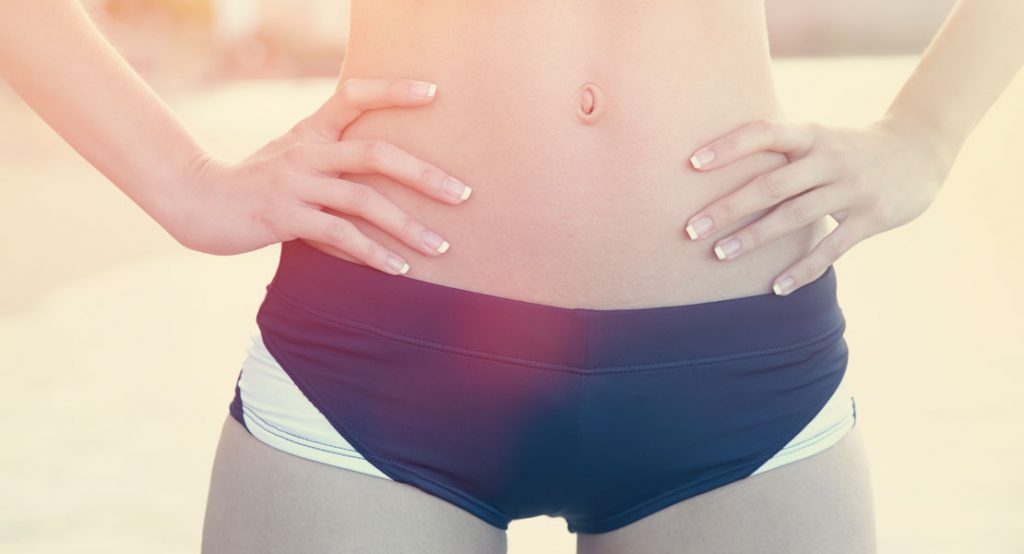Calisthenics is the trend sport for which you don’t need any weights and can still help you build muscle using your own body weight.
Would you like to improve your strength and get your body fit for the summer? How about not having to go to the gym for this, but instead exercising outside? Find out more!
What Is The New Mega-Trend Calisthenics?
The ancient Greeks already advocated this type of exercise – later athletes in New York picked it up again. Since the beginning of the 21st century, calisthenics exercises have spread all over the world thanks to social media. Playgrounds and sports parks are becoming new workout areas where athletes of all fitness levels can train together on bars, scaffolding, steps, etc.
The main thing when doing the exercises is that you do them with concentration and at a reasonable speed. It’s not about who finishes first, it’s about who can strengthen their body in a healthy but extremely challenging way.
By the way, you can find parks in your area specially designed for calisthenics at: calisthenics-parks.com
The Basic Exercises
Calisthenics consists of 5 basic exercises consisting of push-ups, squats, pull-ups, leg raises, and dips. Its difficulty can be easily adjusted, making this workout suitable for both beginners and advanced users.
Make sure that you do them really properly because they form the basis for more difficult calisthenics exercises. If simple exercises don’t work, then later the more demanding ones won’t work either. Don’t let mistakes creep in!
The following applies to all exercises: Repeat them 15 to 20 times per set, fight your way through 3 sets and only take a break of about 1 minute in between. Never forget to build in enough rest between each workout. Since this is a full-body workout, beginners, in particular, should stick to at least 48 hours.
Enough talking, we will now show you the 5 basic exercises with the respective modification options:
1. Push-Ups
Muscle groups that will be strengthened: shoulders, triceps, chest
The implementation: Get on all fours. Then you raise your knees so that only your hands and balls of your feet are touching the ground and your entire body forms a line. The wrists are below the shoulder joints. Lower your torso down while bending your elbows. When your chest almost touches the floor, push yourself back up. Your back remains stable and does not sag.
Beginner: Take the weight off your arms by keeping your knees braced. The straight line in this case is from your head to your knees.
Pro: Vary the position of your hands – put them further outwards or inwards. You can also lift an arm or leg off the floor.
2. Squat
Muscle groups that are strengthened: thighs, buttocks, but also the trunk muscles
How to do it: Stand upright with your feet shoulder-width apart and pointing forward. Keep your arms stretched out in front of you, parallel to the ground, and then lower your buttocks to the floor. Only go deep enough so that your knee joints form a 90-degree angle. The tips of the feet must not protrude beyond the tips of the toes. Then straighten your knees again, powerfully pushing yourself back into an upright position.
Beginners: Start with mini squats, where you only lower your butt halfway.
Pro: Try other variants, such as the sumo squat. It gets particularly strenuous with the pistol squat, where you only do the squat with one leg.
3. Pull-Ups

Muscle groups that are strengthened: back muscles (especially the latissimus), large and small chest muscles, and the upper arm muscles
How to do it: Hang from a bar with your arms shoulder-width apart, your palms or palms facing you. Pull yourself up until your chest almost touches the bar. Hold this briefly and then lower yourself back down to the starting position in a controlled manner.
Beginner: Just hang on to the bar as long as you can and build up enough strength in your hands and arms. You can later support your first pull-up attempts with a flexible band or a training partner to help you.
Pro: Perform the pull-up with just one arm.
4. Leg Raises
Muscle groups that are strengthened: core muscles and especially the straight abdominal muscles
How to do it: Hang from a pole with your arms straight. Raise your thighs so that a right angle forms at the hip and knee joint. Now bring your knees towards your chest as far as you can and then bring them down again, guided. Meanwhile, your upper body remains very still and hardly moves.
Beginners: Don’t start straight away at the bar, instead strengthen your core with lying leg raises. To do this, lie on your back, and at the same time bring your legs straight up so that there is a 90-degree angle in your hips. Your lower back is always touching the ground.
Advanced: Perform hanging leg raises with straight legs and only lower them in slow motion.
5. Dips

Muscle groups that will be strengthened: triceps, pectoralis major, and anterior shoulder
How to do it: Support yourself with your left and right arm on a parallel bar. The elbows are slightly bent and your legs are crossed with bent knees. Keep your body upright if you want to primarily train your triceps. Lean forward for more chest muscle.
Bend your elbows and sink your body down. If your upper body is parallel to the ground, you have reached your target position, from which you can push yourself up again.
Beginners: It will be easier if you put your hands behind you on a step or bench and put your feet firmly on the floor. Then, just sink your buttocks down, taking a lot of the weight off your arms that way.
Advanced: Start your dip from the target position, i.e. with your elbows bent, and push yourself up without momentum.
If That's Not Enough
If you’re really good at the basic exercises, you can now really step on the gas. We’ll show you a few classic calisthenics for advanced users – but there are countless others. The choice of other, more difficult exercises is almost endless.
- Human Flag: Grab a vertical pole, body parallel to the floor
- Hollow back handstand: You are in the bridge position, but your feet are not touching the ground
- (One-Arm) muscle up: like a pull-up, but you push yourself even further into the plank in the top position
- V-Sit: Legs and torso form a V with only hands touching the floor
- Close to Impossible: From the top pull-up position, instead of moving back down, push away from the bar with straight arms and hold
The Benefits Of Calisthenics
Calisthenics is so popular because it has many positive effects:
- Effective muscle building
- Improving overall fitness
- High-calorie consumption
- Stabilization of the body and especially the middle of the body
- Low risk of injury if the exercises are performed correctly
- Changeable
- Training in the fresh air and at any time
- Improving coordination and mobility
- Increase in ambition and willpower
- Stress relief
- Can be done with any fitness level
Are There Any Disadvantages?
Although the advantages of calisthenics clearly outweigh the disadvantages, this training sometimes also has negative effects.
On the one hand, it is quite strenuous and may overload beginners with too much ambition. If you also want to train your buttocks, for example, this will be difficult with this form of training because it always uses the entire body. In addition, you are ruthlessly at the mercy of the weather, especially in the cold season.
If you’re looking for a sport that you can do every day to balance work or study, you might want to look elsewhere. In order not to irritate the body too much, the breaks between the calisthenics units must be observed. If you are still exhausted from the previous day and do not complete an exercise correctly, in the worst case it can also lead to an injury. For this reason, every beginner should first join a training group and learn the exercises perfectly.


